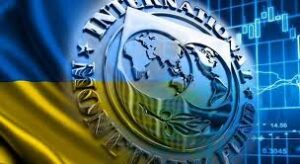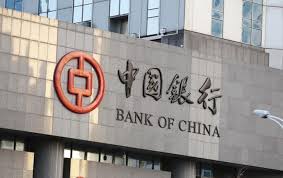
The International Monetary Fund (IMF) has clarified the forecast of Ukraine’s GDP growth in 2024 under the World Economic Outlook (WEO): it expects it at the level of 3.2%, then during the third revision of the EFF Extended Fund Facility program in March estimated it in the range of 3-4%.
According to a publication on the Fund’s website on Tuesday, the economic growth forecast for 2025 was kept at 6.5%, up from 5.3% in 2023, according to the State Statistics Service.
The IMF also expects average annual inflation to slow to 6.4% this year from 12.9% last year and accelerate slightly to 7.6% in 2025.
Ukraine’s current account deficit forecast for this year and next year has been kept at the same level as in the third revision of the EFF program – 5.7% of GDP and 8.2% of GDP after 5.5% of GDP last year.
The Fund also reiterated expectations for unemployment to fall from 19.1% last year to 14.5% this year and 13.8% next year/
The IMF indicated that it forecast growth in the euro zone to accelerate to 0.8% this year and 1.5% next year after 0.4% last year, driven by the strong impact of Russia’s war against Ukraine.
“Stronger household consumption as the impact of the energy price shock fades and lower inflation supports real income growth is expected to support the recovery,” the Fund said, clarifying that the updated estimate is 0.1-0.2 percentage points (p.p.) worse than the previous estimate made in January.
Overall, the WEO said global economic growth, estimated at 3.2% in 2023, will continue at the same pace in 2024 and 2025. The forecast for 2024 is revised upward by 0.1pc from the January estimate.
“These growth rates are low by historical standards, driven by both short-term factors, such as continued high borrowing costs and the withdrawal of fiscal support, and the longer-term effects of the COVID-19 pandemic and Russia’s invasion of Ukraine, weak productivity growth, and increased geoeconomic fragmentation,” the IMF said.
Overall global inflation is expected to decline from an annual average of 6.8% in 2023 to 5.9% in 2024 and 4.5% in 2025, with advanced economies returning to their inflation targets sooner than emerging market and developing countries.
The report also notes that the forecast for global economic growth in five years’ time (at 3.1%) is the lowest in decades. ” An alarming change is the widening gap between many low-income countries and the rest of the world. The growth forecast for these economies has been revised downward and the inflation forecast has been raised,” the Fund states.
Worse still, the report notes that compared to most other regions, estimates of long-term damage for low-income developing countries, including some large countries, are revised upward, indicating that the poorest countries are still unable to recover from the pandemic and cost-of-living crisis.
Its experts attribute the relatively weak medium-term outlook to lower GDP per capita growth, due in part to persistent structural frictions preventing the movement of capital and labor to productive firms. And worsening growth prospects in China and other large emerging market economies, given their growing share in the global economy, will have a negative impact on the development prospects of their trading partners.
According to the IMF, the risks to the global economic outlook are currently balanced. “On the downside, new price spikes triggered by geopolitical tensions, including from the war in Ukraine and the conflict in Gaza and Israel, could, along with the resilience of core inflation while labor markets remain tight, lead to higher interest rate expectations and lower asset prices,” the WEO pointed out.
The fund added that geo-economic fragmentation could intensify, with higher barriers to the flow of goods, capital and people implying slower economic growth due to lower supply.
At the same time, it noted that artificial intelligence and stronger structural reforms than expected could boost productivity growth.
As the global economy approaches a soft landing, the priority for central banks in the short term is to ensure that inflation falls smoothly, avoiding both premature policy easing and excessive delay leading to lagging behind targets, the IMF also said.
“Multilateral cooperation is needed to limit the costs and risks associated with geoeconomic fragmentation and climate change, accelerate the transition to green energy, and facilitate debt restructuring,” the Fund concluded.
More details on macroeconomic indicators of Ukraine and the world, GDP of major countries and other economic topics were discussed in one of the video analysis of Experts club analytical center – https://youtu.be/w5fF_GYyrIc?si=Ymo-FlMFNGfLLdK-.
Subscribe to Experts club channel here: https://www.youtube.com/@ExpertsClub
EXPERTS CLUB, GDP GROWTH, IMF, MACROECONOMICS, UKRAINE, URAKIN

The Estonian Ministry of Finance expects zero growth of the country’s economy at the end of the current year.
According to the forecast published by the Ministry, the reduction in external demand in the second half of last year was stronger than expected, and the expected turn to economic recovery did not take place. This will have the consequence of the lack of growth in the current year.
The Ministry of Economy notes that last year, the exchange of goods contracted globally, driven by the cooling of the Chinese economy and geopolitical tensions. In developed countries and Europe, this was compounded by the rapid rise in interest rates, which was launched to curb inflation, and the deterioration in capital- and energy-intensive activities due to the energy crisis.
Nevertheless, according to the Ministry’s assessment, the factors restraining the development of the Estonian economy have been receding in recent years: price growth has slowed down, wage growth has continued, interest rates have gradually decreased, and there is no high unemployment.
The Estonian Ministry of Finance prepares a financial and economic forecast twice a year, in spring and summer.
Estonia’s GDP in 2023 has decreased by 3.1%. At the end of March 2024, the Bank of Estonia gave a forecast that the country’s GDP decline would slow down to “minus” 0.6% this year and the economy would grow by 3.2% in 2025.
Earlier Experts Club think tank and Maxim Urakin released a video analysis of how the GDP of the world’s largest economies has changed over the past decades, more video analysis is available here –
https://youtu.be/w5fF_GYyrIc?si=BsZmIUERHSBJrO_3
Subscribe to Experts Club YouTube channel here – https://www.youtube.com/@ExpertsClub
ECONOMIC GROWTH, ESTONIA, EXPERTS CLUB, GDP, MACROECONOMICS, MINISTRY OF FINANCE, URAKIN

Ukraine’s international reserves in March, according to preliminary estimates of the National Bank of Ukraine (NBU), increased by 18%, or $6.7 billion – to $43 billion 762.7 million.
“Such dynamics is due to significant (more than $9 billion) volumes of receipts from international partners, which exceeded the net sale of currency by the National Bank and the country’s debt payments in foreign currency,” the NBU website explained on Friday.
In addition, the National Bank noted that $9.32 billion was transferred to foreign currency accounts of the Cabinet of Ministers in March, while $363.5 million was paid for servicing and repayment of the state debt.
As the regulator noted, Ukraine also paid $728.5m to the International Monetary Fund.
Among other factors determining the volume of reserves, the NBU named operations on the foreign exchange market: in March, the regulator’s net sale of foreign currency amounted to $1.79bn, which is 18.5% more than in the previous month.
According to balance sheet data, the NBU sold $1.81 bln on the foreign exchange market and bought $25.9 mln in reserves.
The central bank also indicated that the current volume of reserves was positively affected by the revaluation of the value of financial instruments, adding $266.3 million.
“The current volume of international reserves provides funding for 5.8 months of future imports,” the regulator stated.
As reported, the NBU in January reduced the forecast of Ukraine’s international reserves at the end of 2024 to $40.4 billion from $44.7 billion and to $42.1 billion from $45 billion at the end of 2025. Earlier, Experts Club analytical center and Maxim Urakin released a video analysis of how the GDP of the world’s countries has changed in recent years, more detailed video analysis is available here – https://youtu.be/w5fF_GYyrIc?si=BsZmIUERHSBJrO_3 Subscribe to Experts Club YouTube channel here – https://www.youtube.com/@ExpertsClub
EXPERTS CLUB, GDP, International reserves of Ukraine, MACROECONOMICS, NATIONAL BANK OF UKRAINE, NBU, URAKIN

China’s economy grew by about 4.8% year-on-year in the first quarter, Bank of China forecasts.
Domestic consumption grew stronger than expected. Manufacturing investment increased, production is also recovering steadily, and the trend of industrial upgrading and transformation is evident, according to the bank’s report cited by Xinhua news agency.
A positive factor for Chinese exports was the increase in global demand and improved sentiment in global trade.
Bank of China analysts expect that the second quarter will see an improvement in China’s service sector, resulting in an acceleration of the country’s GDP growth to 5.1%. This will also be facilitated by the authorities’ actions aimed at maintaining significant investment in infrastructure through the use of a wide range of policy instruments.
Earlier Experts Club think tank and Maxim Urakin released a video analysis of how the GDP of the world’s countries has changed in recent years, more detailed video analysis is available here – https://youtu.be/w5fF_GYyrIc?si=BsZmIUERHSBJrO_3
Subscribe to Experts Club YouTube channel here – https://www.youtube.com/@ExpertsClub
Bank of China Economy of China, EXPERTS CLUB, GDP, MACROECONOMICS, URAKIN

The article collects and analyzes the main macroeconomic indicators of Ukraine. In connection with the entry into force of the Law of Ukraine “On Protection of the Interests of Economic Entities during Martial Law or State of War” the State Statistics Service of Ukraine suspends the publication of statistical information for the period of martial law, as well as for three months from the date of its completion. The exception is the publication of information about the consumer price index, separate information on statistical indicators of 2021 and for the period January-February 2022. The article analyzes open data from the State Statistics Committee, the National Bank and analytical centers.
Maxim Urakin, PhD in Economics, presented an analysis of macroeconomic trends in Ukraine and the world based on official data from the State Statistics Committee of Ukraine, the NBU, the UN, the IMF and the World Bank.
Macroeconomic indicators of Ukraine
Maxim Urakin cited data from the National Bank of Ukraine on the improvement of the financial situation in 2023 compared to 2022.
“Last year was marked by a more favorable macroeconomic environment for the financial industry. GDP growth generally exceeded forecasts and inflation rates declined. Even after the downgrade, the discount rate remains high enough to make hryvnia investments attractive. Thanks to the efforts of the National Bank and market readiness, the transition to a policy of managed flexibility of the hryvnia exchange rate was successful. At the same time, this success was ensured primarily by stable receipts from partners within the framework of macrofinancial assistance and an increase in the share of exports of agricultural products,” Urakin emphasized.
The expert noted that the main risks for the economy remain the duration of the war and instability of international aid.
“In the third quarter of 2023, Ukraine’s GDP growth slowed to 8.2%. The negative balance of foreign trade increased by 3.2 times, which is a worrying signal. Public debt has slightly decreased compared to August figures, but in 2024 it may exceed the country’s GDP for the first time, which poses significant risks to economic stability,” the economist said.
The pace of international aid to Ukraine, in turn, has significantly decreased in the IV quarter of 2023 – I quarter of 2024, which could create significant risks to the country’s economic stability,” the economist said.
I quarter of 2024, which may negatively affect the recovery of the economy in the current year under the conditions of war.
Global Economic Outlook
Maxim Urakin also analyzed the global economy, noting a slowdown in growth to 2.2% in 2024.
“Analyzing the dynamics of global GDP shows that the global economy continues to recover from the pandemic, but geopolitical instability has a restraining effect on this growth. According to Maxim Urakin, it is important to monitor developments and adapt to changing conditions to ensure sustainable economic growth in the future. Ukraine, in this context, needs to focus on strengthening domestic political stability, restoring its economic potential and continuing reforms to improve its post-war prospects and strengthen its position on the global stage,” the expert explained.
According to the expert, the current macroeconomic situation in Ukraine and the world requires further analysis. For Ukraine, the main challenges in the coming years will be the need to rebuild Ukraine after the war and public debt management.
Earlier, the Experts Club analytical center released a video on how the GDP of countries has been changing in recent years, more video analysis is available here.

The article collects and analyzes the main macroeconomic indicators of Ukraine. In connection with the entry into force of the Law of Ukraine “On Protection of the Interests of Economic Entities during Martial Law or State of War” the State Statistics Service of Ukraine suspends the publication of statistical information for the period of martial law, as well as for three months from the date of its completion.
The exception is the publication of information about the consumer price index, separate information on statistical indicators of 2021 and for the period January-February 2022. The article analyzes open data from the State Statistics Committee, the National Bank and analytical centers.
Maxim Urakin, PhD in Economics, presented an analysis of macroeconomic trends in Ukraine and the world based on official data from the State Statistics Committee of Ukraine, the NBU, the UN, the IMF and the World Bank.
Macroeconomic indicators of Ukraine
Maxim Urakin cited data from the National Bank of Ukraine on the improvement of the financial situation in 2023 compared to 2022.
“Last year was marked by more favorable macroeconomic conditions for the financial industry. GDP growth generally exceeded forecasts, and inflation rates declined. Even after the downgrade, the discount rate remains high enough to make hryvnia investments attractive. Thanks to the efforts of the National Bank and market readiness, the transition to a policy of managed flexibility of the hryvnia exchange rate was successful. At the same time, this success was ensured primarily by stable receipts from partners within the framework of macrofinancial assistance and an increase in the share of exports of agricultural products,” Urakin emphasized.
The expert noted that the main risks for the economy remain the duration of the war and instability of international aid.
“In the third quarter of 2023, Ukraine’s GDP growth slowed to 8.2%. The negative balance of foreign trade increased by 3.2 times, which is a worrying signal. Public debt has slightly decreased compared to August figures, but already in 2024 it may exceed the country’s GDP for the first time, which poses significant risks to economic stability,” the economist said.
The pace of international aid to Ukraine, in turn, has fallen significantly in Q4 2023 – Q1 2024, which could negatively affect the economic recovery this year amid the war.
Global Economic Outlook
Maxim Urakin also analyzed the global economy, noting a slowdown in growth in 2024 to 2.2%.
“The analysis of global GDP dynamics shows that the global economy continues to recover from the pandemic, but geopolitical instability has a restraining effect on this growth. According to Maxim Urakin, it is important to monitor developments and adapt to changing conditions to ensure sustainable economic growth in the future. Ukraine, in this context, needs to focus on strengthening domestic political stability, restoring its economic potential and continuing reforms to improve its post-war prospects and strengthen its position on the global stage,” the expert explained.
According to the expert, the current macroeconomic situation in Ukraine and the world requires further analysis. For Ukraine, the main challenges in the coming years will be the need to rebuild Ukraine after the war and public debt management.
Earlier, the Experts Club analytical center released a video on how the GDP of countries has been changing in recent years, more detailed video analysis is available here.